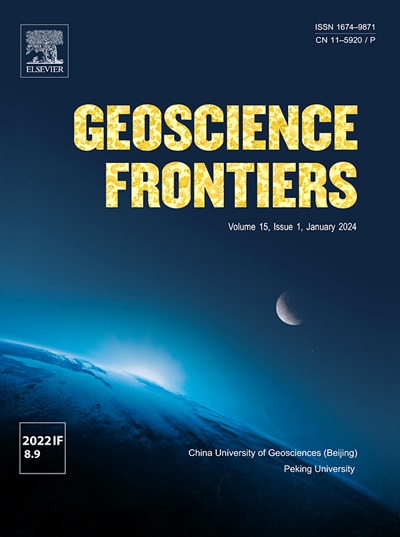Prediction and early warning analysis of reservoir bank slopes based on anti-sliding stability evolution
IF 8.9
1区 地球科学
Q1 GEOSCIENCES, MULTIDISCIPLINARY
引用次数: 0
Abstract
The stability of reservoir bank slopes during the impoundment period has become a critical issue in the construction and operation of large-scale hydropower projects. A predictive and early warning method for reservoir bank slopes is proposed, based on slip resistance stability evolution analysis. Using a refined three-dimensional numerical calculation model of the bank slope, the creep damage model is employed for simulation and analysis, enabling the derivation of stress field and strain field evolution from bank slope excavation to the long-term impoundment period. Subsequently, for the stress field of the bank slope at any given moment, the safety factors of the sliding blocks are determined by using the multigrid method and vector sum method. Accordingly, the evolutionary law of the sliding safety factor for the bank slope can be derived. By integrating the long-term stability evolution trend of the slope with specific engineering practices, the safety factors for graded warning can be determined. Based on the time correspondence, the graded warning moment and the deformation warning index for slope measurement points can be determined. In this study, the proposed method is applied to the left bank slope of the Jinping I Hydropower Station. The results indicate that from excavation to June 2022, the left bank slope exhibits a strong correlation with excavation elevation and the number of reservoir water cycles. The initial, maximum, and minimum safety factors are 2.01, 3.07, and 1.58, respectively. The deep fracture SL44-1 serves as the primary stress-bearing slip surface of the left bank slope, while the safety margin of the fault f42-9 and lamprophyre X is slightly insufficient. Based on the long-term stability evolution trend of the slope and in accordance with relevant standards, the safety factors for graded warning indicators—Kw1, Kw2, Kw3, and Kw4—are determined as 1.350, 1.325, 1.300, and 1.275, respectively. Correspondingly, the estimated warning times are 12/30/2066, 12/30/2084, and 12/30/2120. Accordingly, the deformation graded warning indexes for slope measurement points are established.

基于抗滑稳定性演化的库岸边坡预测预警分析
水库岸坡在蓄水期的稳定性已成为大型水电工程建设和运行中的关键问题。提出了一种基于库岸边坡抗滑稳定性演化分析的预测预警方法。利用精细化的岸坡三维数值计算模型,采用蠕变损伤模型进行模拟分析,推导了从岸坡开挖到长期蓄水期的应力场和应变场演化过程。然后,对任意时刻岸坡的应力场,采用多重网格法和矢量和法确定滑块的安全系数。据此,可以推导出岸坡滑动安全系数的演化规律。将边坡长期稳定演变趋势与具体工程实践相结合,确定分级预警的安全系数。根据时间对应关系,确定坡度测点的分级预警矩和变形预警指标。结果表明:开挖至2022年6月,左岸坡度与开挖标高和库区水循环次数具有较强的相关性;初始安全系数为2.01,最大值为3.07,最小值为1.58。深裂缝SL44-1是左岸斜坡的主要受力滑动面,而f42-9断裂和X煌斑岩的安全裕度略不足。根据边坡长期稳定性演变趋势,根据相关标准,确定了等级预警指标kw1、Kw2、Kw3、kw4的安全系数分别为1.350、1.325、1.300、1.275。相应的,预估预警次数分别为12/30/2066、12/30/2084和12/30/2120。据此,建立了边坡测点变形分级预警指标。
本文章由计算机程序翻译,如有差异,请以英文原文为准。
求助全文
约1分钟内获得全文
求助全文
来源期刊

Geoscience frontiers
Earth and Planetary Sciences-General Earth and Planetary Sciences
CiteScore
17.80
自引率
3.40%
发文量
147
审稿时长
35 days
期刊介绍:
Geoscience Frontiers (GSF) is the Journal of China University of Geosciences (Beijing) and Peking University. It publishes peer-reviewed research articles and reviews in interdisciplinary fields of Earth and Planetary Sciences. GSF covers various research areas including petrology and geochemistry, lithospheric architecture and mantle dynamics, global tectonics, economic geology and fuel exploration, geophysics, stratigraphy and paleontology, environmental and engineering geology, astrogeology, and the nexus of resources-energy-emissions-climate under Sustainable Development Goals. The journal aims to bridge innovative, provocative, and challenging concepts and models in these fields, providing insights on correlations and evolution.
 求助内容:
求助内容: 应助结果提醒方式:
应助结果提醒方式:


